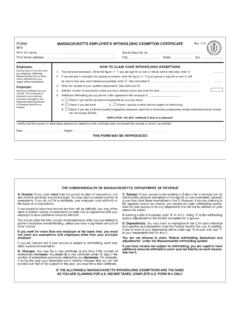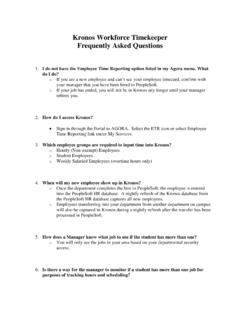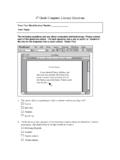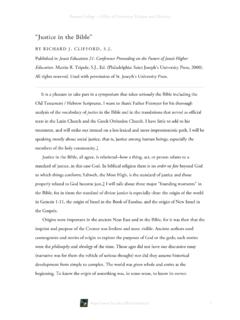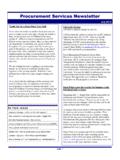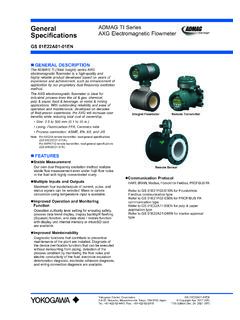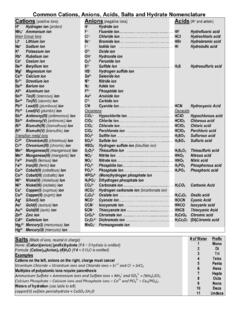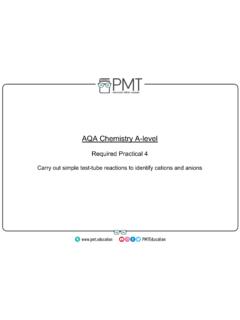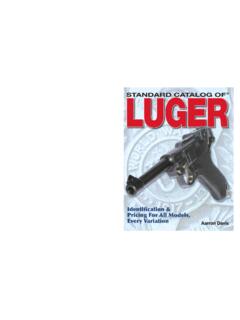Transcription of Experiment 12: Qualitative Analysis of Cations
1 1 Experiment 12: Qualitative Analysis of Cations Pre-Laboratory Assignment The pre-lab assignment for Part A of the Experiment is to complete the flow chart and answer the question on page 10 of this document. There is no pre-lab assignment for Part B. Objective: To separate different Cations in aqueous mixtures using selective precipitation and to confirm their identities using chemical tests. Introduction The Eagle Art Studio and Print Shop had finally found an appropriate space to rent near the center of town. They were able to move into a large vacant room overlooking the baseball diamond and playground of Milford Park. However, the location of an art studio near the park had some of the town residents worried. What if the paints, inks and ceramic pigments that the artists used were being poured into the sinks? Could the metallic components responsible for the colors get into the groundwater?
2 The Town Council contacted the Massachusetts Water Resource Authority, which scheduled tests to be run on the water coming out of the studio. The owners of the shop decided they should do some of their own tests on samples from the sink traps in the building in order to determine what metallic Cations their employees might be discarding into the drains. Principles of the Qualitative Analysis of Cations The process of finding out what compounds are contained in a sample is called Qualitative Analysis . The process of finding out how much of a compound is contained in a sample is called quantitative Analysis . You have used several quantitative Analysis techniques, such as titration and spectrophotometry. During the next three weeks, you will use Qualitative Analysis techniques in order to determine what metallic Cations are contained in aqueous solutions that are provided for you. These techniques will allow you to both separate the Cations in the mixture as well as to identify them.
3 The various salts of the Cations that you will be studying have varying solubilities in water. The differences in solubilities of these salts can be exploited in such a way as to allow for separation of the Cations . As an example, let s examine the Cations calcium, Ca2+, and sodium, Na+. Calcium chloride is readily soluble in water, while calcium hydroxide is highly insoluble in water. By contrast, sodium chloride and sodium hydroxide are both readily soluble in water. An aqueous solution that contains a mixture of calcium chloride and sodium chloride can be treated with an aqueous solution that contains hydroxide ions. The result of such treatment will be the formation of a solid precipitate that is composed of insoluble calcium hydroxide. The sodium hydroxide, on the other hand, remains dissolved in the water. The solid material that contains the calcium ions can be separated from the aqueous solution containing the sodium ions using a technique such as filtration.
4 In summary, the addition of an appropriate chemical reagent to an aqueous mixture of Cations can selectively cause one or more of the Cations to form a solid precipitate while one or more of the Cations will remain dissolved in the water, thus 2 allowing for separation. (Pages 815-820 in Tro also discuss principles involved in Qualitative Analysis .) General Procedures for the Qualitative Analysis of Cations Avoiding Contamination As you follow the procedures for separating and identifying the Cations in a mixture, it will be extremely important to avoid contamination of the samples and chemical reagents at all times. The presence of a contaminant that contains a cation will lead to a false positive result; therefore, it is critical that all glassware be thoroughly cleaned before it is used and should remain clean throughout the procedure. Laying a glass stirring rod on a dirty lab bench, for instance, could lead to contamination.
5 Touching the tip of a medicine dropper to the side of a test tube could cause contaminants to be picked up and transferred to another solution. In addition, all water used for these procedures must come from the plastic, white faucets in the lab that deliver de-ionized water. Tap water from the regular faucets contains a wide variety of ions and could result in misleading observations. Equipment and Chemicals The tests that you will perform to identify the Cations after they have been separated require only very small amounts of sample. Therefore, you will work with the smallest size test tubes available (10 x 75 mm), thin glass stirring rods and medicine droppers. Rather than measuring volumes of liquids with a graduated cylinder, it will be easier to simply count the number of drops of liquid dispensed from a medicine dropper. In general, it is safe to assume that 20 drops from a medicine dropper is equivalent to 1 mL of solution.
6 You will usually be told exactly how many drops to add in any given step of the procedure. As mentioned previously, it is very important that the medicine droppers never become contaminated, for instance, by allowing the tip to touch either the surface of a solution or the side of a test tube. The chemical reagents for the Qualitative Analysis procedures are aqueous solutions that are contained in dropper bottles. Do not put the wrong dropper into a bottle, or the entire contents of the bottle will become contaminated! When you have finished using a bottle, screw the cap back on tightly. If the cap is not on tight, the next person to grab it by the dropper will knock the bottle over. In addition, some of the water will evaporate if the cap is not on tight, and this will alter the concentration of the solution. Mixing After a reagent has been added to a solution in a test tube, it is very important that the solutions are stirred together thoroughly.
7 Reactions cannot proceed to completion unless the reactants come into intimate contact with each other. Use a thin stirring rod to mix the liquids so that the contents of the test tube do not overflow. Of course, the stirring rod must be rinsed well with de-ionized water before being used. Checking Acidity/Basicity In many cases during the separation of Cations , an acid or base solution is added to a sample until the pH of the solution becomes either acidic or basic. In these instances, litmus paper is used to monitor the pH. A drop of the solution being tested is removed from the test tube using a glass stirring rod. The rod is touched to the litmus paper, and 3 the color of the paper indicates whether the pH is basic (blue) or acidic (red). The litmus paper must never be placed directly into the solution! It is possible to use litmus paper to observe if a solution is weakly acidic or basic as opposed to strongly acidic or basic.
8 A strong acid or base will turn litmus paper a more intense color than will a weak acid or base. Forming, Separating and Washing Precipitates When an appropriate chemical reagent is added to a solution containing a mixture of Cations , a precipitate will form that is composed of the insoluble salt(s) of one or more of the Cations . This solid precipitate can be separated from the aqueous solution, which contains the soluble salt(s) of the remaining Cations , by filtration; however, a more convenient technique for the separation of a solid from a liquid is centrifugation. A test tube containing the mixture is placed in a centrifuge, which spins the mixture at a very high speed. The resulting centrifugal force packs the solid material tightly into the bottom of the test tube. The liquid supernatant can then be easily poured away, or decanted, from the solid. Read about Using a Centrifuge in TECH Section VI.
9 Before the liquid supernatant is decanted from the solid material, it is a good idea to check for complete precipitation. After centrifuging the mixture, add one or two more drops of the reagent which caused precipitation to occur. Watch the supernatant carefully to see if more precipitate forms. If no more precipitate forms, then precipitation is complete and the supernatant may be poured off. If more solid does appear in the supernatant, add another drop or two of the reagent solution, thoroughly stir the contents of the test tube, and place it back in the centrifuge for two minutes. The process of checking for complete precipitation should continue until no solid appears in the supernatant upon addition of the reagent. After the liquid has been decanted from the solid, a small amount of this solution will remain behind in the test tube with the solid. In order to completely remove this liquid and any contaminants that it contains, the precipitate is washed with water.
10 Ten to fifteen drops of water are added to the test tube, and the mixture of solid and liquid is thoroughly stirred with a glass rod. The test tube is place in a centrifuge for two minutes, then the water is decanted away from the solid and may be disposed of down the drain. Solids are usually washed two times before proceeding to the next step in the procedure. Heating Solutions Occasionally, a step in a Qualitative Analysis procedure will require that a solution or mixture be heated. A water bath usually provides a high enough temperature. Place about 150 mL of water in a 250 mL beaker and heat it on a hot plate. A metal beaker cover with four holes in it is available in your drawer. This metal plate can be placed on top of the beaker, and 10 x 75 mm test tubes can be inserted into the holes such that the bottom of the test tube is positioned in the middle of the boiling water. It can take some time for the water to reach the boiling point, so if you know you will require a water bath at some point in the procedure, you should set the water on a hot plate at the beginning of the lab period.
